

|
| articles | forbidden stories I-State Lines resources my hidden history reviews | home | |

Writing/Literature Don't Write for Readers, Just Write Grants Ernest Lehman, Screenwriter American Identity Hapas: The New America Can You Tell What I am? Part I Can You Tell What I am? Part II Only in America Self-Reliance Unfolding Crises: Asia China: An Interim Report Shanghai Postcard 2004 Japan's Runaway Debt Train Will Avian Flu Trigger a Global Depression? Battle for the Soul of America A Degree of Success Why the Democrats Keep Losing American Chickenhawks: Your Congress Is This a Nation at War? A Nation in Denial Hawaii National Guard: An Unfair Deployment Financial Meltdown Watch Are We Entering the Next Age of Turmoil? Housing Bubble? What Bubble? Housing Bubble II Meltdown in the E.U. Meltdown: U.S. - China Retirees: the New Elite? Boomers: Prepare to Fall on Your Swords The Real Federal Deficit How much Is a Gallon of Gas Worth? What This Country Needs Is a... Good Recession The End of Cheap Oil Outside the Box How to Make a Favicon Asian Emoticons In Memoriam: Winky Cosmos In a Humorous Vein If Only Writers Had Uniforms One-Word Titles Complacency Nostalgia Health, Wealth & Demographics Demographics and War The Healthiest Cold Cereal: Surprise! 900 Miles to the Gallon Are Our Cities Making Us Fat? Landscapes Terroir: France & California Ideas Do Average People Know More Than Their Leaders? On The Impermanence of Work Flattening the Knowledge Curve: The "Googling" Effect Human Bandwidth and Knowledge History Bad Karma: Election Fraud 1960 Archives: weblog July 2005 weblog June 2005 weblog May 2005 What's New, 2/03 - 5/05 |
Weblog and Wessays Welcome, readers, welcome. Please browse this month's weblogs and the wEssays listed in the sidebar. If you're in the mood for a short story, check out The Adventures of Daz and Alex: Stories of America. (They're all quick reads.) If nothing here strikes your fancy, skim through my recently published articles (generally in the San Francisco Chronicle). If you find something here of value, I would be honored if you linked any essay or story to your website, or printed a copy for your own use. And of course I appreciate your recommendations of this weblog and your comments: csmith@oftwominds.com. August 31, 2005 The Keys to Affordable Housing  This is the new face of affordable housing--the tallest Habitat for Humanity project in the world
(five stories) which was built by the San Francisco affiliate on Mission Street. I contributed to a feature
on affordable housing in Saturday's San Francisco Chronicle highlighting a number of affordable housing
projects which are virtually identical to market-rate housing.
This is the new face of affordable housing--the tallest Habitat for Humanity project in the world
(five stories) which was built by the San Francisco affiliate on Mission Street. I contributed to a feature
on affordable housing in Saturday's San Francisco Chronicle highlighting a number of affordable housing
projects which are virtually identical to market-rate housing.
I've covered affordable housing in the past (a two-part S.F. Chronicle feature in 2001), and my recent research and interviews reinforced these salient points: August 30, 2005 One Serving of Deception As America inexorably gets fatter and less healthy, you'd think some simple improvements like accurate labeling of "food products" would gather steam--but alas, food packaging is often misleading to the point of pure 100% deception of the inattentive or hurried shopper. For instance, take a 20 fluid ounce bottle of Sobe "flavored beverage." (Note the absence of substances such as "fruit juice" in the ingredients.) The Nutrition Facts label, which is printed in such tiny letters that it is difficult to read, states that the drink contains 130 calories per serving. The average shopper can be forgiven for assuming that the bottle would constitute a single serving, since it isn't a jug or liter container. But no, the 20-oz. bottle contains 2.5 servings--a number suspiciously in between two and three. Why? Could it be the bottler chose 2.5 in order to reduce the calorie-count per serving to the modest-sounding 130 calories? One wonders....after all, consumers have every expectation that a serving should be at least 12 fluid ounces--a typical can of soda or juice. At this rate, the bottle of Sobe would contain no more than 1.6 servings. Some very basic math reveals that the single bottle contains 325 calories, an enormous amount for a single drink. Recall that typically-sized human beings require about 1,500 - 1,600 calories per day. This sugar-filled drink (the main ingredient other than water is high-fructose corn syrup, i.e. sugar) is thus about 20% of the entire day's calories. Since there is no nutritional value in the drink whatsoever (it contains trace amounts of echinacea, a substance recently proven to be of no value in fighting colds), then what the drink effectively does is either add 20% empty calories to a person's diet, leading to added pounds of fat (that is, more calories consumed than calories expended), or it replaces calories from actual food with worthless sugar. Either way, the consumer of this beverage is the loser. If product labeling regulations required the posting of a typical serving rather than deceptively tiny servings, the the consumer might have the chance to figure out that this beverage is loaded with worthless calories from sugar without turning to a calculator. August 29, 2005 I Love L.A., But... It's All About Cheap Oil 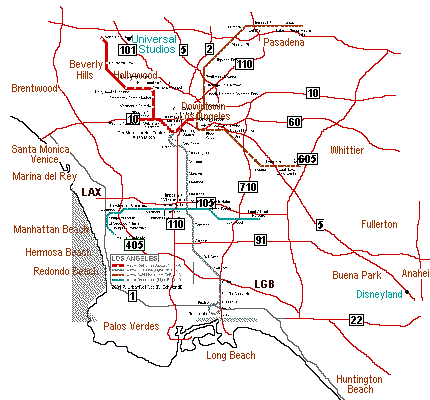 My stepmother, who is Mexican-American, was directing us to one of their favorite Mexican restaurants
in Highland Park, a working-class neighborhood in Los Angeles, when my Dad pointed to the wide median strip
dividing the thoroughfare. "That was where the streetcar to downtown L.A. used to run," he noted, and
it called up images of a bygone era. A streetcar to downtown; imagine!
My stepmother, who is Mexican-American, was directing us to one of their favorite Mexican restaurants
in Highland Park, a working-class neighborhood in Los Angeles, when my Dad pointed to the wide median strip
dividing the thoroughfare. "That was where the streetcar to downtown L.A. used to run," he noted, and
it called up images of a bygone era. A streetcar to downtown; imagine!
The story about how a consortium of tire manufacturers and General Motors bought up the streetcar companies and promptly shut them down is well-known, as is the recent construction of L.A.'s Metro, a light-rail system of four lines: red (Hollywood to downtown), blue (Long Beach to downtown), green (Redondo to Norwalk) and gold (Pasadena to downtown). My poor map is a crude overlay of two transport systems in the L.A. basin: the thin red lines are freeways and the other colored lines are Metro lines. A quick glance reveals that the freeway system is more extensive than the limited reach of the four metro lines. While the Metro is a great start, the vast expanse of the L.A. basin cannot be traversed except by car. Hence: it's all about oil. Yes, crude oil has been pumped out of the basin for decades, but the oil which now controls the region is the refined form which millions of thirsty vehicles require each day to move freely about the basin and beyond. L.A.'s geography and lack of public transit lead to one inescapable conclusion: this is a city dependent on cheap oil. If oil doesn't stay cheap, then L.A.'s 14 million residents (and 13.9 million drivers) will need 13.9 million hybrid or LEV (low emission vehicle) cars and trucks in short order, or they won't be able to afford getting to work. I am a big proponent of bicycles, but you have to live within five miles of your job to make riding a bike to work feasible, and it would seem few in L.A. live that close to their employer--or close enough to make use of the gleaming new Metro lines. Conservation is always the easiest and cheapest solution, and for an example I turn to my humble 1998 Honda Civic, which required 10.3 gallons of gas to travel the 380 miles to Pasadena, or roughly 37 miles to the gallon--and that's with the air conditioner on for 95% of the ride. This is equivalent to all but the smallest hybrid vehicles, and without the added engineering cost of a hybrid. It's simply a small, low-emission gasoline engine powering a light vehicle. No magic there. And there's no magic in calculating that this engine could easily power a small truck or minivan, with the one caveat that acceleration would be somewhat slower than in the Civic. But which would you choose? A vehicle that gets 40 miles to the gallon, or pumped-up acceleration? Your answer might change at, say, $4 per gallon. August 23, 2005 "Oh, and Mr. Stamper--could you please kill Mr. Bond?"  One of the pleasures of the indefatigible James Bond series is the foreknowledge that some variation of
standard Bondian setups are sure to make an appearance in each new entry: gimmicky gadgetry in Q's lab
blowing up a dummy in fiendishly morbid fashion, the exorbitant wealth and malice of the villain, the pining of Ms.
Moneypenny for a good romp with the ever-unattainable James, and
my personal favorite: the moment in which
the heretofore supremely confident evil mastermind finally reaches the boiling point when Bond has once
more slipped from his minions' grasp.
One of the pleasures of the indefatigible James Bond series is the foreknowledge that some variation of
standard Bondian setups are sure to make an appearance in each new entry: gimmicky gadgetry in Q's lab
blowing up a dummy in fiendishly morbid fashion, the exorbitant wealth and malice of the villain, the pining of Ms.
Moneypenny for a good romp with the ever-unattainable James, and
my personal favorite: the moment in which
the heretofore supremely confident evil mastermind finally reaches the boiling point when Bond has once
more slipped from his minions' grasp.
 Various actors have expressed this final frustration in myriad ways--some seething, some explosive, some menacing. My
favorite amidst a very talented field is the scene from Tomorrow Never Dies, in which Jonathan Pryce
(Elliot Carver), his cool aplomb
finally shattered, shouts to his neo-Nazi head thug, so ably played by blondie Gotz Otto: "Oh, and Mr.
Stamper--could you please kill Mr. Bond?"
Various actors have expressed this final frustration in myriad ways--some seething, some explosive, some menacing. My
favorite amidst a very talented field is the scene from Tomorrow Never Dies, in which Jonathan Pryce
(Elliot Carver), his cool aplomb
finally shattered, shouts to his neo-Nazi head thug, so ably played by blondie Gotz Otto: "Oh, and Mr.
Stamper--could you please kill Mr. Bond?"
 The deftness here, of course, is the delivery as a sort of afterthought, when killing Bond is essential
to getting on with his masterplan to take over the world media, which is, as the movie premise has it,
the same thing as taking over the world proper. Phrasing this imperative as a polite request perfectly captures
the character's desperate attempt to control his overwrought fury at Bond's
continued existence--and adds immeasurably to the pleasure of a moment we knew would arrive: the villain's
explosive frustration that, despite the best efforts of his lackeys, Bond refuses to die.
The deftness here, of course, is the delivery as a sort of afterthought, when killing Bond is essential
to getting on with his masterplan to take over the world media, which is, as the movie premise has it,
the same thing as taking over the world proper. Phrasing this imperative as a polite request perfectly captures
the character's desperate attempt to control his overwrought fury at Bond's
continued existence--and adds immeasurably to the pleasure of a moment we knew would arrive: the villain's
explosive frustration that, despite the best efforts of his lackeys, Bond refuses to die.
 It's always amusing to consider the agonies of the casting department--do we dare use an ethnic character for
the evil mastermind?--and it seems the producers of Tomorrow Never Dies called Central Casting,
Department of Acceptable Evil. The Head Snake is Anglo-Saxon, so no one can complain about ethnic profiling; the Head
Henchman is safely neo-Nazi--the proof being blond hair and a vaguely German accent; the
bloodlessly evil Doctor Torture is also Nazi-inspired, as evidenced by his precise manner of speaking and German accent;
and the evil computer geek, who, it is noted, started his career as a student radical at Berkeley, gasp!, is
swarthy and carries the Indian-sounding surname of Gupta, safely non-Arab, non-Asian, non-African-American and non-Hispanic.
It's always amusing to consider the agonies of the casting department--do we dare use an ethnic character for
the evil mastermind?--and it seems the producers of Tomorrow Never Dies called Central Casting,
Department of Acceptable Evil. The Head Snake is Anglo-Saxon, so no one can complain about ethnic profiling; the Head
Henchman is safely neo-Nazi--the proof being blond hair and a vaguely German accent; the
bloodlessly evil Doctor Torture is also Nazi-inspired, as evidenced by his precise manner of speaking and German accent;
and the evil computer geek, who, it is noted, started his career as a student radical at Berkeley, gasp!, is
swarthy and carries the Indian-sounding surname of Gupta, safely non-Arab, non-Asian, non-African-American and non-Hispanic.
What would central casting do without proto-Nazi characters? The world of global film distribution needs non-controversial evil-doers, and thank goodness the collective memory of World War Two guarantees that a somewhat Germanic accent, blond hair and chiseled, frowning visage sends the message loud and clear--this guy is evil. The mastermind, however, must be Anglo-Saxon, for any number of semiotic reasons; Nazis are evil, but they take orders, and Anglo-Saxons make such frightfully believable monomaniacal madmen. I will be away from home for a few days; next entry, August 29. August 22, 2005 Understanding Globalization There are various pretenders to the throne of explaining globalization, such as Thomas Friedman's recent The World Is Flat, but all such efforts seem shallow and pallid compared to the masterwork of the genre, Fernamd Braudel's trilogy Civilization & Capitalism, 15th - 18th Century: The Structures of Everyday Life (Volume 1) The Wheels of Commerce (Volume 2) The Perspective of the World (Volume 3) I do not lightly suggest tackling almost 1,800 pages of reading, but there is simply no substitute (short of a master's degree) if you aspire to an incisive understanding of global trade's role in the social, political and economic history of our world. It is not a boring read--anything but, for Braudel's depth of research, breadth of knowledge and his appreciation for the limits of current scholarship are matchless. Where authors like Friedman incautiously grind whatever axe they set out, drawing upon work which supports their thesis, Braudel is ever-cautious about drawing overarching conclusions from the data he has culled from archives' dusty pages. What Braudel reveals is a world which has been disrupted by far-reaching trade for hundreds of years. Capital has flowed across the great oceans of our globe for far longer than most people realize, destroying local industries in favor of distant ones in the process. It is impossible to summarize such a rich, vast work, but reading even one of these volumes will give you a deep insight into the long history of globalization, and how entire industries and financial centers have been displaced time and again in the Arab Levant, in Asia, and in Europe. You will also come to understand the rise of European economic dominance, and how it cannot be so neatly attributed to guns, steel and germs, as appealing and powerful as Jared Diamond's thesis may be. Braudel does not labor to create broad-brush explanations so much as present the archival evidence he so assiduously assembled in a fashion which describes the flow of history in exacting, living detail. (The books were written in the late 1970s; Braudel died in 1985 at the age of 83.) For example, he shows that prosperity, since at least the 1400s if not earlier, is found in those cities and regions where prices are highest. It is counter-intuitive at first--since shouldn't money go farther where prices are low?-- but the same is obviously true of our era. The most prosperous nations are those with the highest costs, and the poorest are those where prices are lowest. At a minimum, this sheds light on the centuries-old exodus from rural to metropolis, and on the nature of prosperity itself. In other words, each element of his work is not a Powerpoint slide but an interconnected web which informs a wide array of subjects, including social and political history, macro-economics, and how life was lived by ordinary merchants, traders and craftspeople. I recommend these volumes not just for their vast erudition but for the enjoyment gained from his unparalleled mastery of everyday life in distant lands and distant times. Not much has changed, it seems, except the speed of communication between traders and the power of their ships. Bruadel's writing is a pleasure to read even in translation (the original was in French), for his style is lean and spiced with a droll wit which leavens what might appear at first as dry text. In this his writing reminds me of Gibbons (Decline and Fall of the Roman Empire) and U.S. Grant's masterly autobiography. August 21, 2005 A New Short Story I recently completed a new short story (fiction) which I invite you to read, How I Fell in Love with a Homeless Woman. It may surprise you. August 20, 2005 The Housing Bubble III: This Just In: Pop! 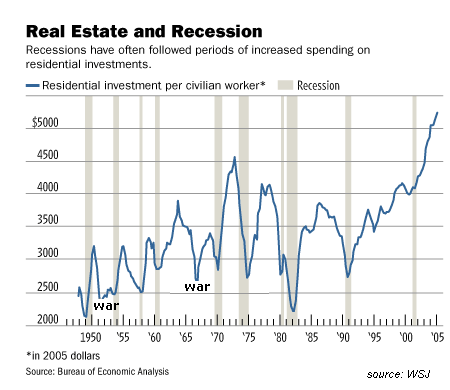
Take a look at this chart and tell me there's no housing bubble, and that real estate can keep on rising indefinitely. What the chart reveals is that over-investment in housing (as measured by investment per worker) is inevitably followed by a recession. The two exceptions which prove the rule were the Korean War and the Vietnam War, which goosed the GDP by 15% and 10% respectively, pulling the economy out of the recession which would have otherwise taken the economy by the throat. The glaringly obvious point is that the present level of over-investment is unprecedented, suggesting that the ensuing recession will be deeper and longer than previous over-investment/recession cycles. It's worth noting that the last "real" recession--that is, one that lasted more than a few months--occurred 25 years ago. That's an awfully long run of expansion. 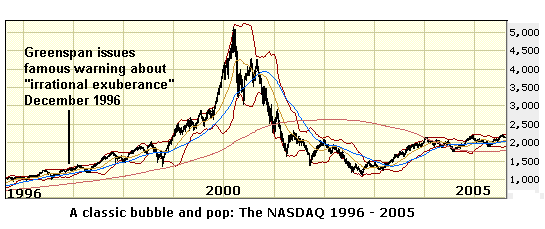
The chart's upward trajectory since 1990 has a eerie, if not downright frightening, resemblance to the
parabolic rise of the NASDAQ stock market 1997-2000. As we all know, the NASDAQ subsequently plummeted 80%.
That couldn't happen to real estate, the yammering industry bulls yelp; maybe so, but what about a 40% drop?
Check back in 2010 and let's see where valuations are then.
Conclusion: the era of cheap oil is nearing an end, and this fact will hinder the development of all industrializing countries. Another point raised by only one commentator is that China has been subsidizing its industrialization with cheap financing (loans to government-owned companies which will never be repaid) and government-financed infrastructure. 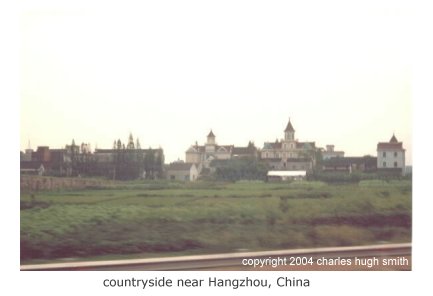 Since
China's rapid industrialization has poisoned its environment and its people, then China has basically underpriced the goods
it has produced. That is, if the cost of scrubbing the pollution pouring from coal-fired plants were priced into
the goods, they would cost appreciably more. And since China will eventually have to
clean up its polluting industries or pay the price in the decline of its workers' health, then the "real cost"
of Chinese-made goods will have to rise.
Since
China's rapid industrialization has poisoned its environment and its people, then China has basically underpriced the goods
it has produced. That is, if the cost of scrubbing the pollution pouring from coal-fired plants were priced into
the goods, they would cost appreciably more. And since China will eventually have to
clean up its polluting industries or pay the price in the decline of its workers' health, then the "real cost"
of Chinese-made goods will have to rise.
In the same way, any comprehensive overview of India and China's economy has to look objectively at cultural issues such as caste, rights of women, corruption, how the rule of law actually operates, etc. For instance, how can India ever claim to be utilizing its citizens' full talents when half the population--the female half--is largely denied equal opportunity? And how can India proceed beyond enriching the top 1% of its people when 160 million Dalits ("untouchables") are marginalized? As for rule of law, it exists in name only if you happen to be trapped in the nightmarish reality of Indian "justice" in which cases take years to even reach trial. (The American justice system is nightmarish, too, of course, but if you had a choice, you'd certainly pick the U.S. system.) As for China, the more you know about pirating and corruption in China, the less sanguine you are about the possibilities of both plagues being eradicated by some new statute. Conclusion: Cultural impediments such as caste, sexism and corruption are obstacles to economic supremacy which cannot be mandated out of existence by laws or policies. 
Conclusion: The top 1% of these societies are elevated as models for the other 99%, but caste and corruption render this a flawed analogy. The software engineers of Bangalore are held as models for all of India, but the entire software industry in India employs less than a million workers, in a country of 1.2 billion. The Chinese yuppies glorified in depictions of Shanghai indulgences such as nightclubs and penthouses are similarly a razor-thin cream on a largely impoverished society. 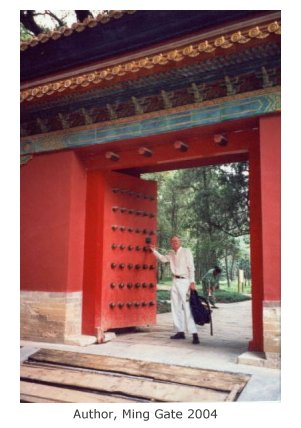 But then capital flows out of countries as well, and while China is currently enjoying huge inflows of foreign
capital, history suggests such a tide of capital can recede as quickly as it flowed in once returns are better
elsewhere. While the Chinese people are prodigious savers, and the central bank sits on foreign reserves of $600
billion, the fact remains that bad bank loans promulgated by the same central government are by most accounts
at least equal to the entire reserves--$600 billion or more. (See
my essay on China's future for more information and links on the true state of China's finances.) By strict
accounting, China is essentially broke; the illusion of big reserves is kept in place by hiding the true size of
bad debt in the system.
But then capital flows out of countries as well, and while China is currently enjoying huge inflows of foreign
capital, history suggests such a tide of capital can recede as quickly as it flowed in once returns are better
elsewhere. While the Chinese people are prodigious savers, and the central bank sits on foreign reserves of $600
billion, the fact remains that bad bank loans promulgated by the same central government are by most accounts
at least equal to the entire reserves--$600 billion or more. (See
my essay on China's future for more information and links on the true state of China's finances.) By strict
accounting, China is essentially broke; the illusion of big reserves is kept in place by hiding the true size of
bad debt in the system.
The basic model of fast economic growth in the post-war era has been the export-driven economies of Japan, Taiwan and South Korea. In this model, domestic savers generated large amounts of capital which the central banks loaned to corporations at low rates to fuel their worldwide expansion. While that seemed to work wonders without the need for foreign capital, the downside of such a policy is visible in the 15-year malaise of the Japanese economy. Without the pressures of competitive capital, there has been no political or financial will to tear down the structural barriers which have been slowly strangling Japan's economic vibrancy. Growing to superpower status without risking the whims of foreign capital is a nice dream, but foreign capital is also what keeps an economy honest, transparent and competitive. The current boom in China and India is also widening the gap between the haves and the have-nots--a situation we share in the U.S. The question is: are the cultures of India and China truly able to grow a culture of meritocracy and opportunity? While the gap is widening statistically in the U.S., there are so many examples of regular folks making immense fortunes in the U.S.--Oprah Winfrey, Steve Jobs, Larry Ellison, Bill Gates, Warren Buffet, George Lucas, et. al.--that it is hard to make the case that upward mobility is dead in the U.S. Any study of the economies of China and India should note that a culture of injustice and inequality drives convulsions like the Cultural Revolution or the great urban riots in the U.S. in the late 60s. All the repressed injustices of a society tend to boil over violently once the dream of upward mobility is revealed as false. Some have pointed to the rise of the U.S. as an industrial power as an analogy to the current rise of China and India. But it is a false analogy in one key manner: the U.S. took in tens of millions of Europe's abject poor, as the European economies failed to create employment for their deprived and economically immobile citizens. But the hundreds of millions of poor Chinese and Indians cannot immigrate to the U.S. or elsewhere, and so those country's failures to offer employment opportunities to their poor will fester in-country. There is no longer a safety valve in "The New World;" we have only this one old world of diminishing forests and oil for all of us. August 17, 2005 A Real American Meal (another foodies post)  What makes bar-be-qued chicken and potato salad such an iconic American meal? The kimchee, of course
(the red-colored bowl in the lower left of the photo). Kimchee adds just the right zest to the Korean-style
chicken, and brightens up the steamed carrots and broccoli.
What makes bar-be-qued chicken and potato salad such an iconic American meal? The kimchee, of course
(the red-colored bowl in the lower left of the photo). Kimchee adds just the right zest to the Korean-style
chicken, and brightens up the steamed carrots and broccoli.
Reflecting our mix-and-match heritages, mix-and-match cuisines are the glory of American cooking. With a crisp little white zin for those with a sweeter palate or a nice rounded syrah for those who like a full red (or a Sierra Nevada pale ale if you prefer beer with kimchee), this is a meal fit for citizen-kings and queens. A serving of couscous would have fit well, too, or a dish of dal or aloo gobi, or chard provencal.... August 16, 2005 The Village Bakery in France (enough about the economy; let's talk food)  Even Americans who loathe French culture place one
element of French life on a pedestal: the French way with food. Although it may seem to have started with
those precious books about the lad-di-da life in Provence by breathlessly awed Americans--"they actually
sit down for lunch! I burst into tears at the sheer joy of it all"--its roots trace all the way back to
Benjamin Franklin and Thomas Jefferson's leisurely posts in France as representatives of the nascent United
States of America.
Even Americans who loathe French culture place one
element of French life on a pedestal: the French way with food. Although it may seem to have started with
those precious books about the lad-di-da life in Provence by breathlessly awed Americans--"they actually
sit down for lunch! I burst into tears at the sheer joy of it all"--its roots trace all the way back to
Benjamin Franklin and Thomas Jefferson's leisurely posts in France as representatives of the nascent United
States of America.
The boys had a grand old time in Paree, schmoozing it up with French politicos and bigwigs and downing the trendiest wines of the time. (No word on how Tom's companion and favored slave, Sally Hemmings, fared.) Recall that Franklin and Jefferson each served the Republic at different times, not concurrently, and that the presence of the French fleet at Yorktown sealed the fate of the British army trapped onshore. (No French fleet, no victory for the rebellious colonies.) Jefferson's stint as American diplomat in France launched his interest in wine-making, that necessary precursor to wine drinking, and as a result he set up vineyards and a winery at his rural estate in Virginia, Monticello. In the interest of fairness, it should be noted that Jefferson was an equal-opportunity drinker, as he also brewed beer in the basement of Monticello. 
As you can imagine, the Francophiles reigned supreme in the young States, for the thrilling rhetoric of the new French Revolution was certainly sympatico with the young Republic's ideals. Anglophiles either fled to Canada or dear old England, or simply kept their mouths shut; after all, some 40% of the Caucasian population of the colonies supported the British Crown's attempt to suppress and eradicate the rebels. So before you lay waste to French snootiness and its kissing cousin, French anti-Americanism, remember that the Founding Fathers lucky enough to nail down a post in Paris found a very congenial atmosphere. In other words, despite all the precious blather written about the City of Lights (as in lighten your wallet, je pense) and Provence--not that the ga-ga Americans actually toil under the hot Provencal sun to nurture those glorious fresh vegetables or old vines; they hire local peasantry to actually do the real living--there is something to the notion that the French do appreciate food and the taking of meals in a way which is utterly foreign to our Fast Food Nation. By way of example, consider the essential role played in rural life by the village bakery. Villages which lose their bakery lose an essential component of French life, and so the loss of a village baker is a communal tragedy. One village in the Cevennes region (west of fabled Provence) lost its baker to an auto accident, and the blow to the community cannot be adequately described to an American inured to buying plastic-wrapped loaves of unknown origin from a supermarket. My brother (a resident of those parts for many years) reports that there is a shortage of bakers nowadays, for the usual reasons: it's hard work with wretched hours, and young people hope to become bankers or hip-hop stars (practically the same thing, only bankers prefer Mercedes over Bentleys), not village bakers. The baker in a nearby village occasionally drinks too much, which interferes with waking up in the wee hours of the morning to start the day's bread, and so the village is rather understandably annoyed to arrive for the morning bread and find not fresh bread but a hung-over baker. But the difficulties of replacing a baker preclude even the slightest remonstrance--perhaps one under the breath--but the risk of alienating a community treasure far outweighs the brief pleasure of a sound scolding. The photo above is of the bakery in my brother's small village. When I visit, we make the short walk there and buy the morning's croissants and bread. Neaby bakeries make the biologique (organic) whole-grain breads preferred by my family, but the village bakery certainly gets their business. Though the proprietors do not speak English, my schoolboy French suffices; heck, you can always just point to what you want and hold out a euro or two-- French bread and pastries are cheap by American standards. The closest analog I can suggest to the importance of the village bakery is Main Street in an older American town. The French bakery is Main Street; without it, the rest of the village businesses wither away. With a bakery, you might support a cafe and a restaurant, and retain your equally valued post office; but without a baker and a bakery-- le village, c'est fini. August 15, 2005 Circle of Self-Interest Americans often seem puzzled that various and sundry nation-states don't seem to act in accordance with our wishes--a view which is the very height of self-absorption. Why shouldn't every nation, group, family, clan and person act in their own self-interest? When Iran wants the leverage provided by nuclear weapons, for instance, and we want to deny them that leverage so that it can't be used on us or our allies, then the clash of interests is in sharp relief. Yet when things seem to go our way, as it has with China's industrialization and support of our low interest rates, then we imagine the world is working as it should. But what is actually happening is simply a virtuous circle of self-interest: the Chinese need to employ 400 million disenfranchised ex-farmers, and so expanding their industrial base at a breakneck pace is very deeply a matter of self-interest. (Never mind nagging details like pollution, peasant land rights or intellectual rights; there's no time for such hindrances.) 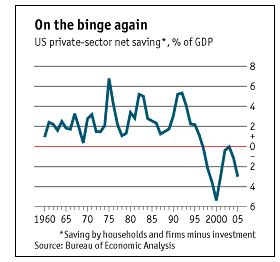 Additionally, they need to enable their largest customer base, the U.S. consumer, to continue to buy their
manufactured goods, and so pouring hundreds of billions of their trade-surplus dollars into U.S. Treasuries
is not an act of kindness ("Those poor Americans, unable to save a dime; let's help them out by keeping
mortgage rates at 40-year lows") but rank self-interest.
Additionally, they need to enable their largest customer base, the U.S. consumer, to continue to buy their
manufactured goods, and so pouring hundreds of billions of their trade-surplus dollars into U.S. Treasuries
is not an act of kindness ("Those poor Americans, unable to save a dime; let's help them out by keeping
mortgage rates at 40-year lows") but rank self-interest.
In a similar fashion, the redoubtable American consumer (if he or she is also a homeowner, which is about 70% of the population) looks at the enormous increase in their "real wealth" as reflected in their rising home equity and promptly reckons it's unnecessary to save any wages. And this makes perfect sense: why bother stashing away $500 a month in a savings account earning a paltry return when you've already "saved" $100,000 in the past few years via your increased home equity? Indeed, studies have shown that increases in home value make the owners "feel richer" and as a result they spend freely, confident in their growing wealth. The Federal Reserve, for it's part, is happy to flood the economy with liquidity, i.e. easy money, in order to keep the economy floating ever upward. (A sharp recession, after all, can ruin your whole day, not to mention your career.) The Fed raises short-term rates, but long-term rates (mortgages, etc.) are set not by the Fed but by the market--and so as long as the Japanese and Chinese central banks continue to buy U.S. bonds and keep mortgages cheap, then the American consumer will continue to spend lavishly on Japanese and Chinese-made goods. And so the circle of self-interest is complete--everybody's happy, except for a few malcontents who see the overloading of debt on the U.S. economy as the weight which will eventually sink the ship. But why can't the circle of self-interest continue indefinitely? Whay can't the Asian central banks support the U.S. consumer and reckless U.S. government borrowing forever? As long as American consumers continue shipping boatloads of dollars to Asian manufacturers, then the Asian banks will have to recycle that half-trillion dollars somewhere--and why not in safe, reliable U.S. Treasuries? 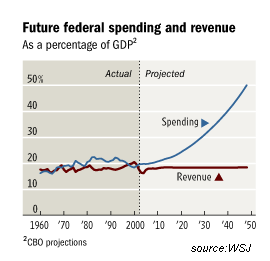 There is no magic here, and as a result there is no way to know when the circle will break, or what will cause
the various player's self-interest to diverge. But history suggests there will be a divergence, or an external
break in the circle, and then the vicious cycle of more expensive debt and falling home equities will replace
the virtuous circle of ever-cheaper money and ever-rising property values.
There is no magic here, and as a result there is no way to know when the circle will break, or what will cause
the various player's self-interest to diverge. But history suggests there will be a divergence, or an external
break in the circle, and then the vicious cycle of more expensive debt and falling home equities will replace
the virtuous circle of ever-cheaper money and ever-rising property values.
Cries of dismay will arise, but there will be no overseas saviors or Federal Reserve magic to mend the virtuous circle; gravity will exert its force on all those trillions of dollars of debt, and those with adjustable-rate or interest-only mortgages or other short-term debt--including Uncle Sam--will be the poorer for it. August 13, 2005 China Trade Surplus: Gusher Profits for U.S. Corporations Alarmist headlines blare the "bad news": China's trade surplus with the U.S. is at record highs. But if this is so bad for the U.S., why are U.S. corporate profits at record highs? Could the two facts be related? Of course they are. U.S. companies' manufacturing of goods in China is creating enormous profits, not for the Chinese but for American corporations. 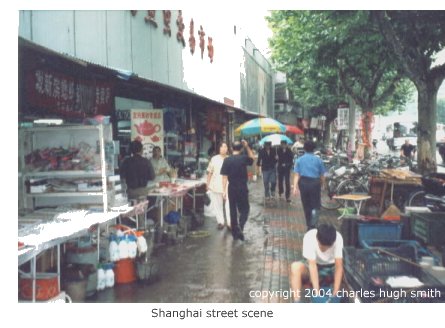
As every American shopper knows, American companies are having just about everything made in China these days-- to the tune of about $230 billion a year. In doing so, they have slashed manufacturing costs in half or more, even including the cost of shipping. But have you ever noticed the price of these items dropping in half as a result of these cost savings? Of course not. The companies have been retaining the savings as corporate profits. Just how big are corporate profits nowadays? Try $1.1 trillion--fully 10% of the entire U.S. GDP. As a result, U.S. corporations are sitting on a cash horde of some $634 billion, which is rising by tens of billions each year. Various factors have been identified as the proximate causes of this unprecedented profit gusher: per unit labor costs have actually dropped 5% since June 2001, the largest drop on record; the low cost of borrowing money, and improving productivity--in other words, the usual suspects: lower costs equal higher profits. Of course there is truth in these three reasons: the cost of borrowing money has never been lower, the influx of 400 million Chinese workers into the world economy has devalued labor worldwide--as simple supply and demand would dictate--and productivity has improved modestly. But the elephant in the room no one talks about is the enormous U.S corporate profits being made by moving manufacturing to China. John Q. Citizen naively assumes China is making huge profits selling stuff to American consumers, but this is simply incorrect; how many items do we buy made by Chinese corporations? Virtually nothing; maybe a few million dollars' worth of Haier dorm-room fridges and some foodstuffs, but everything else is made in China either by or for American corporations. In other words, the Chinese don't own all the manufacturing--foreign corporations own or co-own a significant share. Direct foreign investment in China reached $153 billion in 2004. And those manufacturers which are Chinese-owned aren't necessarily profiting by the manufacturing boom. By all accounts, Chinese contract manufacturers--that is, those Chinese-owned factories which make goods for U.S. companies under contract--must compete fiercely with each other for the business, which means that they all operate on razor-thin profit margins in the neighborhood of 3%. Surely some of these enormous cost savings have been passed onto American consumers? Indeed, it has been estimated that American consumers have saved $100 billion since 1978 as a result of lower cost goods made in China. But as this same essay in Foreign Affairs details, corporate profits made from manufacturing in China far exceed these relatively meager savings. Recall that the U.S. economy is about $12 trillion, with some 75% of that being consumer spending. Thus we can estimate total U.S. consumer spending since 1978 as being about $200 trillion (in current dollars, $8 trillion per year multiplied by 27 years.) Given the size of consumer spending since 1978, then the $100 billion in savings shrivels to near meaninglessness. Which is to say that American corporations have pocketed the really big money--as evidenced by their $1.1 trillion in profits annually. As one example of savings, he Foreign Affairs essay noted that Ford saved over 40% by having its car radios made in China. That number seems low, as anecdotal evidence suggests that many manufacturers are having items made in China for 25% of their previous costs. So how much corporate profit is directly attributable to the move by U.S. corporations to manufacture their products in China? I have been unable to find any statistics--who wants to publicly identify such a politically sensitive source of outsized profits?--but let's be charitable and guess that American corporations are pocketing $2 for every $1 they spend having stuff made in China. Could U.S. companies be reaping $400 billion in profits by having all their goods made in China for $200 billion? Could the Chinese be making a paltry $6 billion making all that stuff? Until I find hard evidence to the contrary, then all data suggests that the beneficiaries of the manufacturing boom in China are multinational corporations, not the American consumers or the Chinese workers (average pay, $100 per month) or even the owners of Chinese factories. This is nothing new, of course; as Fernand Braudel so painstakingly showed in his three-volume history Civilization & Capitalism, capital knows no boundaries; it flows, as it has flowed for hundreds of years, to the biggest returns. But that's another entry. August 12, 2005 The Last Redwood in Anderson Valley 
No visit to California could possibly be complete without a visit to the grand majesties of the terrestrial Earth, the redwoods. (The giant cetacea are the grand majesties of the oceanic Earth.) Small groves of Coastal Redwoods are located in Big Basin State Park (Santa Cruz) and Muir Woods (Marin), with the largest stands protected in the Humboldt Redwoods State Park and Redwood National and State Park of Northern California. Two groves of Giant Sequoia are nestled in Yosemite National Park and a larger forest is in the aptly named Sequoia National Park in Central California. All are worth a visit. (There are 19 state parks preserving redwoods or sequoias; click here for the list.) A lesser-known and therefore less visited forest of coastal redwoods can be found in the Anderson Valley of Mendocino. The redwoods in Hendy Woods State Park almost didn't survive; in an old, oft-told tale of humanity reaping the "profits of Nature," every last redwood in the valley was slated for logging until one individual (not a "tree-hugger", but a businessman who recognized the loss entailed by the cutting of every last one of the magnificent, irreplaceable redwoods) fought to save the last stand. After much effort with various allies, this last grove of redwoods--a small patch of what once covered the great long valley--was bought by the state. (There is another stand of redwoods at the western end of the valley, Navarro River Redwoods State Park, but it contains second-growth redwoods, not the ancients found in Hendy.) I highly recommend a drive through the Anderson Valley to either visitor or resident. It harbors quintessential Californian scenery, from the coastal fog and rough rock-strewn shores to the lushness of redwoods to the vineyards of the valley slopes to the arid oak-dotted hills of the eastern entrance to the valley. (Roederer Estates is certainly worth a stop if you like sparkling wines; click here for a complete list of valley wineries.) The significance of the Hendy Redwoods is two-fold; first, the redwoods were saved by the determined effort of one individual; let no one say that one or two people cannot make an enduring difference: they most certainly can, and the Hende forest is proof. Secondly, it shows the incredibly short-sighted stupidity of the human race, for we as a species will cut down the last tree, hook the last fish and shoot the last tusked mammal to reap the short-term "profit" of "harvesting" the death of a species. We as a species are impoverished by such heedless, merciless liquidation, if not directly then indirectly; and the planet is most assuredly improverished by the loss of local species and habitats. Look no further than the cod fisheries of the Eastern seaboard, the Matto Grosso of the Amazon or the silent jungle canopies of central Africa for current examples of such short-sighted, irreparable destruction. August 11, 2005 (sorry for the two-day lapse; I was camping in Lassen National Park) Can You Create Creativity? Singapore, it seems, is betting that creating creativity is the ticket to economic success in a world where manufacturing anything anywhere but China appears to be a losing proposition. But as this story from the S.F. Chronicle suggests, it isn't that easy to create creativity. Malaysia is the poster child of the "we're gonna create a Silicon Valley right here" fantasy, having poured millions into a new business park called Cyberjaya. It has the glittering buildings and the fast fiber-optic cabling and the big parking lots--but no Apple Computer will ever be born there, and and it's highly unlikely any "disruptive technology" (the PC, the Internet, the web browser, etc.) will be invented there, for the obvious reason that it's not the buildings which make Silicon Valley, it's the people, the spirit, the networks and the money which make Silicon Valley--and indeed, California as a whole-- the place where many innovations begin, grow and then spread around the world. It sounds like magic in a bottle, and to some degree it is; you cannot just hire talented people and give them money and a lab. You also need the culture which nurtures innovation, creaitivity and risk-taking: people who aren't just talented, but people who are willing to go for broke, the big change-the-world ideas. Then you need overlapping networks of like-minded people willing to encourage the risk-takers to go for it, people who have the experience of both failure and success, people with connections to the labs, university departments, sources of capital, patent attorneys, marketers, and all the other nutrients which must be present for innovation to take root and grow. And of course you need multiple sources of big money, both from the government to fund basic research which has no immediate practical market value, and then private funding which comes without strings of corruption or government interference. And lastly, you need low taxes, so that entrepreneurs can start businesses without high overhead. It is possible for relatively rigid societies to foster innovation; I would place Japan and Korea in this category. Both societies do not encourage entrepreneurs as much as comradeship and loyalty to a large organization-- generally a multinational corporation, a university or a government department. You are much more likely to find a female scientist at UCSF (University of California-San Francisco) than in any major Korean or Japanese lab, and as a result much of the talent in both nations is squandered because the brains are in female bodies. (We have so many friends in both countries, we know this first-hand as well as via statistics.) Korea has taken a lead in cloning technology, and has rapidly growing multinationals like Samsung and Hyundai; but if we are objective, we have to conclude that, like the Japanese, their successes are derivative of innovations begun elsewhere. This is not a reflection on the people as much as the pooling of talent and funding in major corporations. Thus we have the questionable efforts of Honda and other companies to manufacture human-like robots; at enormous expense, these firms have fashioned clumsy machines which can climb stairs in a painfully slow mimickry of human abilities, raise their arms, etc. But these machines are fundamentally useless in the real world, toys which play well to crowds but which are incapable of doing any fiscally sensible work. Only a top-down corporation would so lavishly fund such a dead-end technology. Similarly, there were a number of "scare books" in the mid-80s touting the Japanese government's push for a "fifth generation" artificial intelligence which would leapfrog American technology, leaving us in a doomed netherworld of also-rans. Have you ever bought any A.I. products from Japan? The effort was a complete waste of money. Top-down efforts at innovation simply don't work. Not only that, but when a solitary genius does discover something in a big corporate lab, he hightails it to the U.S. if he wants to reap any rewards. Consider the man who invented the blue-green laser in Japan; he has since moved to U.C.-Santa Barbara. I recently watched the documentary Dogtown and Z-Boys Which leads to a simple conclusion: future technological revolutions will not come from autocratic societies like Singapore, Malaysia, Japan or Korea (throw in France and the rest of the EU, too, for different reasons) because whatever counterculture lives in these societies is entirely marginalized, where in California it is heralded and admired. So what makes a counter-culture? You can start with: a roving, curiosity-driven desire to question authority, to strike out on one's own, to think freely, to tolerate creativity's inherent messiness, to accept failure, however painful it might be personally, as part of the process and as part of the deal. Accepting failure, even repeated failure, isn't easy, but California is blessed with numerous successful role models--not just Steve Jobs, Larry Ellison, George Lucas and Steven Spielberg, but less well-known heroes like James McKerrow, whose lab at UCSF has tackled the six worst parasitical diseases around the world--those that affect poor people in poor countries--and is close to developing treatments for three of them. But government policy must be part of the equation in some industries, such as photovoltaic (PV) solar cells for generating electricity. Here, the U.S. is way behind--except for California, which is close to passing the "Million Solar Roofs" legislation which will subsidize the installation of solar panels on hundreds of thousands of buildings in the state. The state also funded stem cell research to the tune of $3 billion, dwarfing any other nation's research budget and neatly bypassing the Federal government's idiotic restrictions. Counterculture and government--sounds like an unlikely, even contradictory recipe for innovation and rebirth, but it's true. Bottom line: if you're more interested in whether a person fits your idea of the right race, sex, creed, religion, sexual orientation, clothing, caste, clan or favorite flavor of ice cream, rather than what they can accomplish, then you're never going to spark any innovation, ever. What do you get in California that you don't get elsewhere? Most importantly, a chance to succeed or fail, and admiration for the failures; but there is much else besides, for instance Ask a Scientist. August 8, 2005 "Open the Kimono" and Other Techie Slang This Dilbert strip caused me to ROTFLMAO, i.e., LOL i.e. laugh out loud. 
A quick web search turned up an excellent techie slang dictionary What They Really Mean Is... Here are a few phrases which struck a chord with me:
The basic idea behind my plan is to refinance the national debt (or at least part of it). I believe that Social Security is fundamentally sound with a few minor adjustments. However, the $1.6 trillion trust fund will need to be repaid. Also, I believe that there are some issues to be addressed with ownership of our bonds. Specifically, 28% of our federal tax revenue serves to pay interest on the national debt, interest that is going to benefit foreign governments and the wealthy. Furthermore, pensions in America are facing a crisis. I believe that we could create personal add-on accounts that are invested in bonds (refinancing the trust fund) that serve to create a completely safe pension plan for all Americans (including lower income workers).His website is PactAmerica. Check it out if you're concerned about Social Security and the ballooning share of U.S. debt held by other nations' central banks. August 6, Hiroshima and the First Use of a Nuclear Weapon I will address this in a future entry, but for now consider Thinking about the Unthinkable It's sobering to consider, but what would you do if you were a policy-maker in "nuclear-ready" countries such as Japan, South Korea and Taiwan if you read China's blustery threats of killing millions with nuclear weapons? I know what I would do--secretly develop my own nuclear arsenal as fast as possible. The nuclear genie seems to have irrevocably escaped the bottle 60 years after its first use. For this we can thank Nazi Germany, whose pursuit of fission weapons drove the U.S. to undertake the Manhattan Project. Once the U.S. had mastered the technology, the Soviets stole the recipe via spies. Now the world finds Pakistan openly selling the secrets and technologies to any and all bidders. That's a forbidding development to ponder on August 6th. I will leave you with one final thought. An elderly friend of ours who is Japanese was "drafted" in 1943--along with all the other 8th graders--to toil in munitions factories buried deep in mountainsides around Japan. As a resident of Kyoto, she was shipped to Maizumi, on the Japan Sea (western side of Honshu). She recalls seeing the glow in the sky as the great city of Osaka-some four hours away by train--burned to the ground as a result of conventional bombs dropped from American B-29s. To witness the destruction of a vast city from such a distance is horrendous evidence that conventional bombing was also terribly effective. August 5, 2005 Iraqi Guangxi? First, let me thank astute reader Ben Z. for these improved links to two articles on the housing bubble that I recently referenced in my wEssay "Housing Bubble II": In Treating U.S. After Bubble, Fed Helped Create New Threats (6/09/05), and What Happens If Real Estate Goes Bust (6/12/05) Also of interest is a fictionalized account of the coming Great Unraveling entitled The Day After Tomorrow. 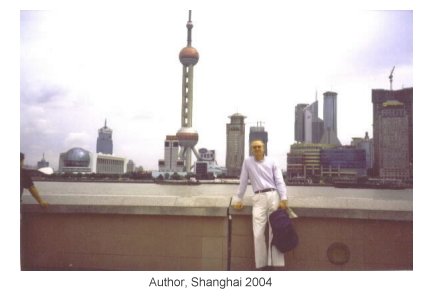 I would like to honor a brave journalist, Steven Vincent, who went to Iraq as a free-lancer. It is difficult
to state the danger a free-lance journalist who is not "embedded" in a protective unit of the U.S. Armed Forces faces in Iraq;
there is no protection except one's own intelligence network, street moxie and luck.
Apparently Vincent was hot on the trail of a "weird tangle of criminal gangs, Iranians coming over, and the
corruption" in the Basra Police force. A more dangerous set of foes would be hard to imagine--criminal gangs,
Iranians and corrupt Police--as these are precisely the people who desire secrecy most ardently.
I would like to honor a brave journalist, Steven Vincent, who went to Iraq as a free-lancer. It is difficult
to state the danger a free-lance journalist who is not "embedded" in a protective unit of the U.S. Armed Forces faces in Iraq;
there is no protection except one's own intelligence network, street moxie and luck.
Apparently Vincent was hot on the trail of a "weird tangle of criminal gangs, Iranians coming over, and the
corruption" in the Basra Police force. A more dangerous set of foes would be hard to imagine--criminal gangs,
Iranians and corrupt Police--as these are precisely the people who desire secrecy most ardently.
If you substituted "offshore Chinese" for "Iranians," you would have a remarkably accurate description of the state of affairs in China, where corruption and "guanxi" rule beneath the surface of apparent government control. Thus the photo of Shanghai, which is certainly a city built on guanxi. When it was stripped of influence during the 50s and 60s, it was a backwater; but once the ideological grip of the Gang of Four was loosened, Shanghai regained both its vigor and its guanxi (interlocking obligations and financial dealings between various people with some degree of either power or money). It is now the New York of China, relegating Beijing to the status of Washington D.C.--the seat of central government but of little else. The revelations Vincent was beginning to reveal--the heavy penetration of Iranian influence into the Police Force, the British error in ceding control of Basra to the religious leaders tied to the Iranians, the terrible corruption threading through everything from the Police to reconstruction funds--lead me to wonder if anthropologists wouldn't make the most valuable analysts in Iraq. It seems obvious that we as a nation will never understand how to repair the fractured social contract in Iraq without a complete grasp of Iraqi "guanxi" and how tribal/family connections power a pervasive and debilitating corruption. Interestingly enough, these same issues threaten to undermine all that's been accomplished in China; for a fuller explanation, take a look at my essay China: An Interim Report". It should be noted that criminal gangs in China are not necessarily the violent street-level drug dealers who characterize gangs in the U.S; they are sophisticated networks which may well control drugs and prostitution but whose more lucrative business is counterfeiting software, DVDs, medicines and more. Members of criminal triads are often intimately linked to those in power, often through family or clan connections. For more on Chinese triads, read The Dragon Syndicates: The Global Phenomenon of the Triads One complexity burdening Iraq but not China is the interplay of conflicting religions and ethnic identities. Despite this, not all parts of Iraq are as bleak as the headlines might lead you to believe. For a fascinating "on the ground" look at events in Mosul, Iraq, check the blog of Michael Yon, another free-lance journalist in Iraq. August 4, 2005 Unspoken Memories 
This is a somber stone marker on the outskirts of the small village where my brother lives in the south of France. It is a typical ancient village of perhaps several hundred people, little changed from 60 years ago, or with the exception of electricity and indoor plumbing, even 160 years ago. French speakers will have to forgive my schoolboy French translation of the marker: "Killed by the Germans here, July 19, 1944. The French Dead: Rene Plantier, 26 years old Elie Boniface, 28 years old Adolphe Monteux, 21 years old. They died so that France may live." It is unlikely such executions of civilians were unique to that village; the Nazis killed many suspected members of the Resistance. Summary execution is a particularly heinous, brutal crime, especially when practised as a matter of policy. Imagine if every small village lost three young men to such execution without trial. War between civilians and an occupying military force, as we know so well, makes justice difficult-- but certainly not impossible. That's the burden of the occupiers. The marker reminds me of the plaques which can be found at the entrance to every major temple in South Korea. Each plaque contains one key phrase: "This temple was destroyed by the Japanese in 1597." Indeed, it seems the Japanese invaders burned and looted every major temple and capital building in the whole of Korea during their conquest. With this fact embedded in the memory of every visitor to every temple, is there any wonder that the Koreans are highly sensitive about the terrors inflicted on Korea by Japan in the early 20th century? Clearly, to the Koreans, it was just one in a long series of repeated abuses--the destruction of cultural monuments, the enslavement of women for prostitution, the forced labor of Korean craftsmen in Japan, and the mandatory teaching of the Japanese language in Korean schools. These immense horrors are not easily forgotten or forgiven. I wonder if beneath the apparently cordial relations between France and Germany lies a lingering but unspoken reticience in the collective French consciousness regarding the German people. If our countryside were littered with memorials to those executed in cold blood by German soldiers, I would have the gravest doubts about the depth or sincerity of any official friendship with Germany. Americans rather famously have short memories, but other nations are not so quick to forget the brutalities of needless wars inflicted by aggressors. August 3, 2005 Airport Walkabouts We've all had the experience of a long layover in an airport--not long enough for a quick jaunt into the city, but too long for comfort. One fruitful way to pass the time is an airport walkabout-- that is, a walking tour of the airport. The benefits are many: some exercise before a long sitting spell in a pressurized metal tube (a.k.a. an airliner), a bit of fascinating people-watching, and the chance to observe the busy scurry of a transport hub. Although hardly a world-traveler, I've found that some airports lend themselves to an interesting walk more than others. Here is a short list of airports I've wandered about: August 2, 2005 The End of Empire Is Real Simple Don't the excesses of our society quiver with an "End of the Empire" feel? I reckon we know what the ancient Romans felt when the Barbarians were at the gates of Rome and the oblivious citizenry rose to their feet in the Coliseum to demand ever more spectacle. We are witnessing the masses rise to their feet, seeking diversion and luxury even as the storm clouds gather on the horizon. Could anything exceed the tawdriness of Grand Theft Auto-type videogames in which violence, mayhem and degrading sex are paraded as "entertainment"? How about "reality television," in which participants hunger so cravenly for even fleeting fame that they willingly submit to swallowing worms and competing in "risky" cretin's games. You want to play "Survival"? Well how about joining one of the National Guard units in Iraq, or an NGO (non-governmental organization) relief mission in Iraq, if you prefer. A society which craves the molded-plastic "danger" on television but is so nonchalant about the dangers faced by 150,000 of its finest citizens in Iraq is not just blind; it is sick. No, Americans want their survival to be assured; risk isn't humping 90-pound bundles of shingles on a roof-- you might actually get hurt! Better to leave that real danger to immigrants and other faceless folks. Much better to prove yourself with a tattoo that hurts for a few minutes. You'll have to forgive us for being unimpressed with your bravery and vision and whatever else you reckon the little procedure means. Besides, your parents will pay to have it lasered off in a few years when it's no longer fashionable. Then there's the indulgences of a consumer religion truly run amok, in which the grossest waste and tackiest excesses are held on high like false gods: Hummers, a truly useless vehicle unless you live in Alaska or perhaps North Dakota, and even then you'd want a pickup truck, not a flat box with almost no storage capacity; ugly stucco-box McMansions, filled with rooms no one even steps foot in except to deposit more belongings; huge U-storage facilities in every suburb, to store whatever the bursting-to-the-seams garages can no longer hold. And for the few who actually read rather than watch 100 channels of vacuity, glazed-eyed, there are the magazines heralding the End of Empire: Real Simple and Outdoors, and dozens more of the same ilk, platforms for advertising to people with too much money and too much time, and no sense of urgency about anything but their next purchase. Sample article in Outdoors: "Luxury Camping: Five Star Comfort in the Wild." Is this what camping and the outdoors is all about, or is it merely blatant worship at the alter of the Consumer Gods? I somehow doubt John Muir or Thoreau would be waxing euphorically about how "five-star luxury" is really what Nature is all about, and how pathetic and shorn of beauty the redwoods are unless you're lounging in five-star comfort. As for Real Simple, the irony is so obvious that it strains credulity that someone would have the chutzpah to name a magazine chock-full of adverts aimed at the bourgeoisie "a guide to simple living." Doesn't it strike you that the first step towards a simpler lifestyle is getting rid of stuff, not buying more? And if you need a magazine to explain how you could own less stuff and be less harried, then you probably won't wonder why all this downsizing requires buying different (and always high-end) stuff. If there is anything to the notion of karma, then America could do with another financial depression in which the excesses are squeezed from an economy and a culture bloated with indulgence, debt and blind obedience to the Gods of Consumerism. Once you don't have any extra money or credit to spend, then your life tends to get Real Simple Real Fast. To anticipate a Great Unraveling is not an indulgence in schadenfreude; it's just anticipating the inevitable: what goes up must come down. August 1, 2005 The Wheeled Vagabonds A few blocks from my residence lies a fallow stretch of street fronting a local government maintenance building. As the other side of the street is occupied by a school, there are no houses on the entire block, and as such, there are no cars parked here as on other residential streets. Into this void has flowed the Wheeled Vagabonds, those hardy souls who live in their cars, vans or converted school buses. Though living on the street is prohibited, the local Police obviously turn a blind eye to the practise, as long as the Vagabonds don't cause any trouble. I reckon their presence actually makes the neighborhood safer, as their eyes are most certainly on the street. Despite the cramped quarters, they fashion a life not unlike the more traditional apartment or house dweller; at least one has a friendly dog, and he keeps his bicycle locked on the back bumper of his old van. I'm not sure how the Wheeled Vagabonds take care of their bathroom needs, but I would guess a trip down to the marina or other public facilities works passably well; on such a quiet street, they don't need to worry about losing their parking space. In my various bike rides around the city I've spotted a few other such quiet non-residential areas where the Vagabonds gather; I assume they switch locales from time to time to avoid any possible legal entanglements. Even if they aren't assets per se to the neighborhood, they are certainly benign; after all, if you lost your job, or aren't able to find work, then living out of a vehicle is pretty much the only cheap way to live in this area. It sure beats being totally on the street, i.e. homeless. This practise is probably far more widespread than commonly recognized. On a recent visit to my Alma Mater, the University of Hawaii at Manoa, I chanced upon a familiar car and its grizzled occupant. The man once ran some film festival on campus for a time, and I suppose this thin connection to the University enabled him to obtain a parking pass. Now his car, stuffed to the ceiling except for the driver's seat, has been his home for an unknown number of years. I wonder how many other campuses across the country have similar Wheeled Vagabonds residing in inobtrusive nooks and crannies. Just after graduating from college, I briefly considered buying a small sailboat and living on it, reckoning that the dock fees would be appreciably less than rent in righteously expensive Honolulu. Alas, the dock fees were not much less than the rent on my fleabag studio apartment, so I gave the idea up. But a van has nearly the same room as a small sailboat interior; why is the former acceptable but the latter unacceptable as alternative housing? wessay noun, combination of 'web' and 'essay,' denoting a short essay which exploits the hyperlinks, interfaces and interactive capabilities of the World Wide Web; coined by Charles Hugh Smith on May 1, 2005, in Berkeley California. |
||
|
|
home |